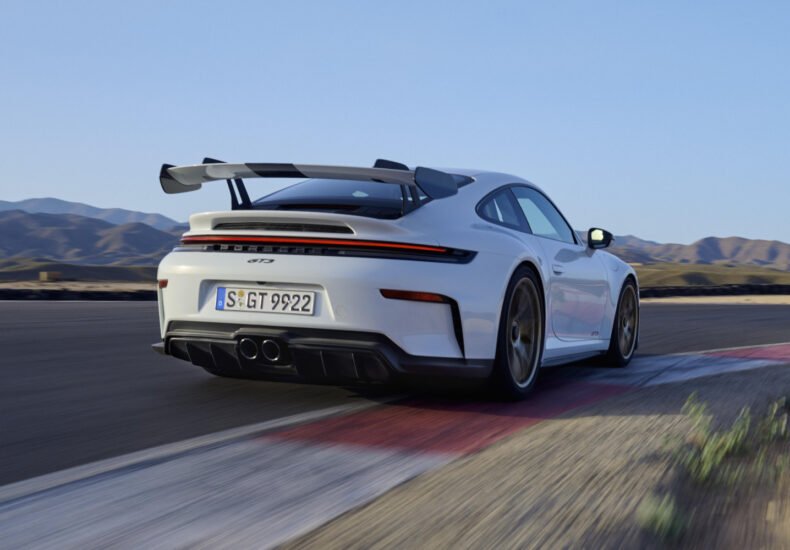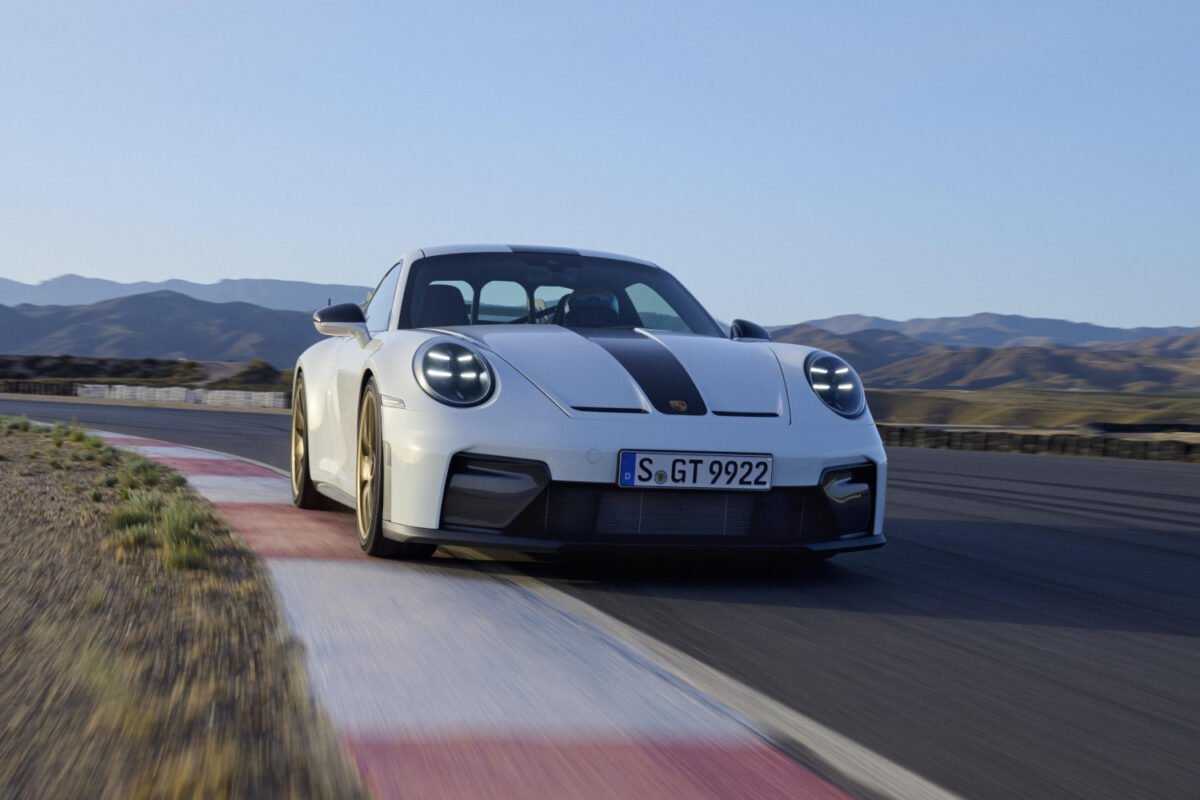
2025 Porsche 911 GT3 – 10 Fast Facts
In 2024, Porsche unveiled the new (992.2) version of Porsche’s road-legal track car. Here are 10 fast facts about the 2025 Porsche 911 GT3.
2025 Porsche 911 GT3 – 10 Fast Facts
4.0-Litre Engine
The heart of the 2025 Porsche 911 GT3 is the a naturally aspirated 4.0-litre boxer engine. It delivers maximum power output of 375 kW (510 hp) at 8,500 rpm. The maximum torque of 450 Nm is available at 6,250 rpm.
Motorsport Developed Technology
The naturally aspirated engine has features that were originally developed for motorsport. Only a few modifications were needed to make the car suitable for use on the road. The six-cylinder engine has six individual throttle valves. A dry-sump lubrication system with a fully variable oil pump and separate oil tank takes care of the oil-supply requirements. The heavily loaded connecting-rod bearings are lubricated directly by oil pump via the crankshaft.
Rev-Limit at 9,000 rpm
The boxer engine can rev up to 9,000 rpm. To make this possible, Porsche uses solid cam finger followers instead of hydraulic valve lifters. Titanium connecting rods, forged pistons and an additional oil supply via the crankshaft ensure stability at high engine speeds. Plasma-coated cylinder walls reduce friction.
PDK Or Manual
The 911 GT3 is fitted with a seven-speed dual-clutch PDK transmission. A six-speed GT sports manual transmission with automatic intermediate throttle function (Auto Blip) is available as an option. For both the PDK and the GT sports manual transmission, the final-drive ratio is eight per cent shorter compared to the previous model. This ensures greater agility and high-revving exhilaration in all gears, as well as noticeably improved overall dynamics.
Hi-Perf Brakes
The brake system features six-piston aluminium monobloc fixed callipers on the front axle and four-piston callipers on the rear axle. The brake discs have a diameter of 408 mm at the front and 380 mm at the rear. The braking system has been designed to provide braking power also for track driving.
PCCB as an Option
If you want even more braking power, the Porsche Ceramic Composite Brake (PCCB) system is available as an option. The brake discs measure 410 mm at the front and 390 mm at the rear. They are characterised by their high thermal load capacity and low mass. The brake discs have a weight about half that of comparable cast-iron discs. The resulting reduction in unsprung mass significantly improves the driving dynamics.
Anti-Dive System
The GT3 has new anti-dive system, which is adopted from the 911 GT3 RS. The front ball joint of the lower control arm is set lower on the front axle. This gives the control arm a steeper angle. When braking, this generates torque that counteracts the suspension compression, which significantly reduces pitching motion.
Aerodynamically Designed Wishbones
For the first time, Porsche is using special aerodynamically designed wishbones on the front suspension of the 911 GT3. With an aerodynamic teardrop-shaped profile, the lower wishbones optimise air movement in the wheel housings, which are subject to powerful airflows. In this way, they reduce lift and direct the air to the front brakes for cooling.
Redesigned Bump Stops
Porsche has redesigned the bump stops of the suspension struts on the new 911 GT3. Shorter bump stops extend the spring travel on the front axle by 27 mm and on the rear axle by 24 mm. This reduces wheel-load fluctuations and the directional behaviour of the tyres, which is particularly noticeable when driving over kerbs or bumpy sections on the race track.
How Fast is It?
The 2025 Porsche 911 GT3 with the manual transmission can accelerate from zero to 60 mph in 3.7 seconds and to 100 km/h in 3.9 seconds. The top speed is 313 km/h. With the PDK transmission, the 911 GT3 is even faster. It can sprint to 60 mph in 3.2 seconds to 100 km/h in 3.4 seconds. The top speed with the PDK is 311 km/h.


Images by Porsche
You may also like
Latest Additions
- 1997 Porsche Boxster – 10 Fast Facts
 For the model year 1997, Porsche unveiled a completely new mid-engined sports car. Here are 10 fast facts about the 1997 Porsche Boxster
For the model year 1997, Porsche unveiled a completely new mid-engined sports car. Here are 10 fast facts about the 1997 Porsche Boxster - What is the Type 986
 Do you know what is the type 986? If you are not familiar with the Porsche code, here is a quick guide to the type 986
Do you know what is the type 986? If you are not familiar with the Porsche code, here is a quick guide to the type 986 - Python Green 2021 Porsche 718 Cayman GTS 4.0
 What do you think about a 982 Porsche 718 Cayman in green? Check these images of a Python Green 2021 Porsche 718 Cayman GTS 4.0
What do you think about a 982 Porsche 718 Cayman in green? Check these images of a Python Green 2021 Porsche 718 Cayman GTS 4.0 - Take a Look – 2019 Porsche 911 Carrera S Exterior
 The eight generation (992) Porsche 911 Carrera is wider, more assertive, and more muscular than its predecessor
The eight generation (992) Porsche 911 Carrera is wider, more assertive, and more muscular than its predecessor - Manthey Kit for the Porsche 911 GT3 (992.2)
 For drivers who have a passion for track driving, Porsche and Manthey have developed the Manthey kit for the Porsche 911 GT3 (992.2)
For drivers who have a passion for track driving, Porsche and Manthey have developed the Manthey kit for the Porsche 911 GT3 (992.2) - 2021 Porsche 718 Cayman GTS 4.0 MT (982) Specs
 Here are the technical specifications of the 2021 Porsche 718 Cayman GTS 4.0 with the 6-speed manual transmission
Here are the technical specifications of the 2021 Porsche 718 Cayman GTS 4.0 with the 6-speed manual transmission - 2021 Porsche 718 Cayman GTS 4.0 – 10 Fast Facts
 For the 2021 model year, Porsche introduced a new variant of the 718 Cayman. Here are 10 fast facts about the 2021 Porsche 718 Cayman GTS 4.0
For the 2021 model year, Porsche introduced a new variant of the 718 Cayman. Here are 10 fast facts about the 2021 Porsche 718 Cayman GTS 4.0 - Peek Inside – 2017 Porsche 718 Cayman Interior
 The interior of the Cayman mirrors the exterior’s strong emphasis on horizontal lines. Let's peek inside the 2017 Porsche 718 Cayman interior
The interior of the Cayman mirrors the exterior’s strong emphasis on horizontal lines. Let's peek inside the 2017 Porsche 718 Cayman interior - Porsche 718 Boxster (982) Option Codes (MY2017)
 Here are the fourth generation Porsche 718 Boxster (982) option codes with descriptions from model year 2017
Here are the fourth generation Porsche 718 Boxster (982) option codes with descriptions from model year 2017 - 2026 Porsche 911 Turbo S is a Hybrid Supercar
 Porsche's T-Hybrid technology, which has since been significantly further developed, is powering the 2026 Porsche 911 Turbo S hybrid supercar
Porsche's T-Hybrid technology, which has since been significantly further developed, is powering the 2026 Porsche 911 Turbo S hybrid supercar
